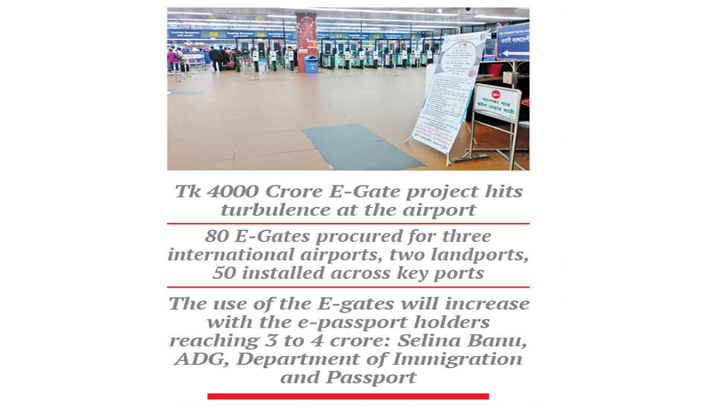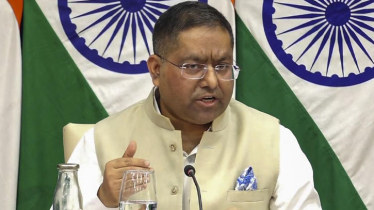
Photo : Messenger
The E-Gate, a significant component of a colossal project amounting to Tk 4000 crore, remains largely inactive. Despite being implemented at three international airports and two land ports in the country, its practical utility is minimal. Originally designed to streamline the immigration process for e-passport holders departing abroad, the E-Gate has encountered numerous operational challenges.
Despite the envisioned swift completion of immigration procedures within seconds, passengers find themselves compelled to undergo manual scrutiny by immigration officials, fielding a series of questions. This manual intervention has led travelers to opt for the conventional immigration gates instead of utilising the E-Gate. Consequently, the pioneering E-Gate, representing the first of its kind in South Asia and incurring a substantial investment, now stands dormant and unused.
Additional Superintendent of Police Nasreen Akhtar from the Immigration Department at Hazrat Shahjalal International Airport affirms that the E-Gate is indeed functional. It is specifically designed for the convenience of e-passport holders. Despite its operational status, there is a noticeable lack of people utilising the E-Gate. Ms Akhtar notes that the reasons behind this underutilisation lie within the domain of the Department of Passport and Immigration officials, who are better positioned to provide insights into the current situation.
According to the information provided by the Passport and Immigration Department, Hazrat Shahjalal International Airport has been equipped with a total of 27 state-of-the-art e-gates manufactured by Germany. Additionally, six e-gates each have been deployed in Shah Amanat International Airport in Chattogram and Sylhet Osmani International Airport. Furthermore, Benapole hosts four e-gates, and Banglabandh features two, all these e-gates are currently operational.
The immigration e-gate at Hazrat Shahjalal International Airport was inaugurated on June 6, 2022, marking the introduction of this advanced facility to expedite the immigration process for travelers holding e-passports.
Since the introduction of the e-passport on March 22, 2020, the Department of Immigration and Passports has successfully issued e-passports to approximately one crore citizens. Notably, Shahjalal International Airport, with an average monthly influx of 5 lakh passengers, has experienced a relatively low adoption of the e-gate system. Since its launch, only 1 lakh 15 thousand passengers have opted for the e-gate, accounting for a mere 2 percent of the total e-passport holders.
Following its inauguration, the e-gate initially saw some usage from passengers during immigration processes. However, challenges arose with the server complexity of the central e-passport system. Many e-passport holders have encountered instances where the e-gates were closed upon exiting the airport, contributing to a decline in its usage over time. Presently, the utilisation of the e-gate has dwindled to zero.
Selina Banu, the Additional Director General of the Passport and Immigration Department, has informed The Daily Messenger that the e-gate system is actively in progress and not closed. The department is committed to providing ongoing customer service to ensure its functionality. It's important to note that the e-gate is exclusive to e-passport holders, as manual processing is still in place for Machine Readable Passports (MRP).
Given that the issuance of e-passports has been provided to approximately 1 crore individuals, the limited number of e-passport holders has naturally translated into fewer users of the e-gate.
Selina Banu suggests that one of the potential reasons for the limited usage of the e-Gate could be the challenge faced by individuals in adapting to the new technology. The unfamiliarity with the system may generate skepticism among users, who might be cautious about encountering issues or getting stuck in the machine during operation. The introduction of a new technology often brings about a learning curve, and it's possible that individuals are still in the process of becoming comfortable with the e-Gate system.
Banu also anticipates that as the number of e-passport holders increases, reaching three to four crore people, the adoption and usage of the e-Gate are expected to become more streamlined.
In response to inquiries about the functionality of the E-Gate machinery, Selina Banu stated that if any issues arise, the Passport and Immigration Department is equipped with engineers to address them. The E-Gate system involves the installation of various electronic devices, and if a malfunction occurs, it could be related to a specific component. Potential reasons for malfunctions might include device damage or fluctuations in technical power.
Banu emphasised that the department has dedicated and trained personnel who work full-time to manage and maintain the E-Gate system. She expressed confidence in the capabilities of the trained staff and conveyed the belief that there shouldn't be any complications hindering the smooth operation of the E-Gate system.
Ziaul Haque Palash, the Additional Superintendent of Police at the Airport Armed Police, shared his observation that the E-Gates at the airport are often vacant. He points out that even if passengers opt for the E-Gate, they still have to go through the immigration officer manually afterward. This additional step may discourage passengers from using the E-Gate, making it seem less efficient in its current state. Palash notes that the initial goal of enhancing passenger services through the E-Gate doesn't appear to be fully realised at present.
However, he offers an optimistic perspective, suggesting that the effectiveness of the E-Gate may increase with a rise in the number of passengers holding e-passports. The implication is that as the adoption of e-passports grows, the utilisation of the E-Gate could become more prevalent.
Wing Commander Kamrul Islam, the Executive Director of Shahjalal Airport, affirmed that the E-Gate is indeed operational. Despite its current underutilisation, he expressed pride in the accomplishment of constructing the first gate of its kind in South Asia. Islam suggests that the key to enhancing the usage of the E-Gate lies in the increasing number of e-passport holders in the country.
The E-Gate at Shahjalal Airport was inaugurated with great enthusiasm, marking a significant milestone as the first in South Asia. The system was designed to allow passengers to swiftly complete their immigration process in just 18 seconds. The process involves holding the digital photo page of the passport in front of the E-Gate monitor, which triggers the opening of the glass door within 10-15 seconds.
Upon entering and following the designated rules, the camera captures pictures of the passenger. If all details are in order, the passenger can proceed through the E-Gate to stand in front of the scanning gate. The entire immigration process is then automatically completed within 5-6 seconds after verifying all the information stored in the e-passport. Officials present at the E-Gate are available to assist individuals in using the e-passport correctly.
Messenger/Fameema








